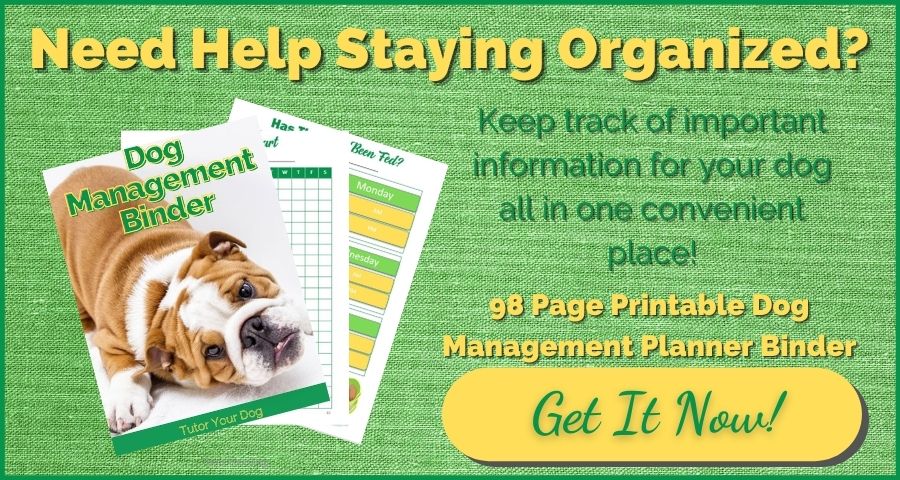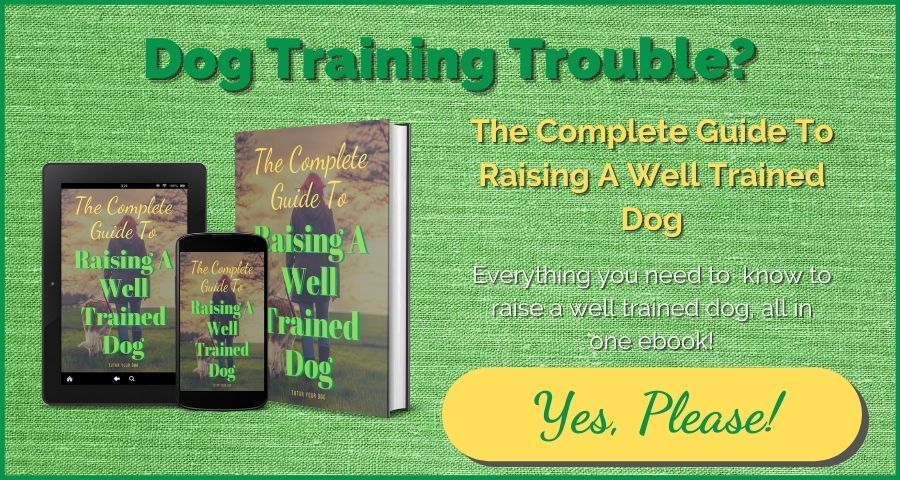{This post may contain affiliate links. This means we may make a small commission at no extra cost to you. This website is a participant in the Amazon Services LLC Associates Program. As an Amazon Associate we earn from qualifying purchases. We only recommend products that we believe will be of value to our followers. Click HERE to see our disclosure for details.}

Many of us suffer from anxiety or know of someone who does. That uneasy feeling that makes it difficult to function in your day to day activities. Anxiety can have a huge impact on a person’s life. What many people do not realize is that dog anxiety is just as common as it is in people. There are things that you can do, though, to help a dog with anxiety. Understanding what causes dogs to have anxiety is helpful in order to know how to help the dog cope with anxiety.
What Causes Dogs To Have Anxiety?
There are a few main reasons for dog’s to suffer from anxiety. These include:
•separation anxiety (which is the most common type of anxiety in dogs)
•fear
•aging
•sickness or disease.
What Are The Symptoms Of Dog Anxiety?
Subtle Signs Of Anxiety In Dogs:
•Panting
Of course dogs will pant when it’s hot outside or if they just had a run. But if your dog is panting for no apparent reason, it could be due to anxiety.
•Not Eating
If your dog stops eating, it’s important to find out why. Rule out any medical reasons first. If your dog does not have a medical reason for not eating it could be due to stress.
•Running Away
Dogs will often run away from something that they are afraid of. They could escape your yard, cower in a corner or just simply run from whatever they find stressful and intimidating.
•Excessive Licking Or Chewing
Some dogs will chew their fur when they are stressed. You will notice patches of hair that have been chewed off. Other dogs may constantly lick themselves when they are stressed.
•Unable To Settle
A dog that is constantly pacing and unable to settle could very well be suffering from anxiety.

Noticeable Signs Of Anxiety In Dogs:
•Destructive Behaviors
Other signs are more noticeable such as destructive behaviors. Dogs suffering from anxiety have been known to chew furniture or walls and destroy other objects within their reach that they have never shown an interest in before.
•Accidents
A perfectly housetrained dog may get himself so worked up that he could start having accidents in the house.
•Excessive Barking
Excessive barking and even howling are other signs to watch for.
•Aggression
The most severe sign is a dog that, all of a sudden, becomes aggressive, even with his family. This symptom can put you and your family in danger.
*If your dog, who normally is not a threat, suddenly shows signs of aggression towards you or a member of your family, you should seek the advice of a trained animal behaviorist as soon as possible. This is not something to try to deal with yourself as there is obviously a major problem and you will need help to get the problem fixed before someone gets hurt.

How To Help Your Dog Deal With Anxiety
Some symptoms are very subtle but if you watch your dog closely you can pick up on them. The subtle symptoms include excessive panting. Of course, dogs will pant if they just came back from a good run or if they are hot. If they are panting without reason then it could be anxiety. Some dogs will shake when they are nervous or anxious. If you find that your dog is chewing or licking excessively, he could be suffering from anxiety, although ruling out allergies or dry skin is important. Some dogs will chew the hair completely off their legs when they are suffering from anxiety. Some dogs may hide from you or some dogs may want extra attention and won’t want to leave your side, it all depends on the dog’s personality. If you see any of those subtle signs, your dog could be suffering from anxiety.
It is important to not punish your dog for anxious behavior. Punishing your dog can create more anxiety and make the problem worse. It is also important not to console your dog when he is anxious. Consoling your dog can be misinterpreted by him as rewarding the behavior, therefore inadvertently reinforcing the behavior. The first step to helping your dog deal with his anxiety is finding the source of his anxiety. Sometimes this can be very easy to figure out but sometimes you will need to closely observe your dog to find out what is causing problems for him.
Tips To Help A Dog With Anxiety
1. Desensitize
Once you figure out what the source of your dog’s anxiety is, you can start to socialize him in order to desensitize him to the cause. Control the environment and reward your dog for any positive behavior. This can take a long time, so patience and consistency is the key. Expose your dog slowly to the thing that is causing him the anxiety. When your dog shows no signs of anxiety, reward him. If he is still very anxious, you may need to take a step backwards and then try again on another day.
If he suffers from separation anxiety, start off leaving him alone for just a minute. When he becomes comfortable with that gradually increase the time until he can be left alone while you are gone to work or gone out to run an errand.
2. Use pheromones
There are some other things that you can do for your dog to help with his anxiety. The first one we will mention is pheromones. They come in pheromone collars, plug ins and sprays. Our favorite of the three is the collars as it is always with them. With the plug ins and sprays, you would need to have them in various rooms of your house but they do work well too if your dog doesn’t like wearing a collar. These collars, plug ins and sprays work by releasing a synthetic pheromone. They work like the pheromone hormone that is produced by a lactating female to bond with her puppies. The collars and plug ins last about a month.
3. Massage
A relaxation method that can calm his anxiety is massage. Tellington Touch works well for anxious dogs. It works by using circular motions with your hands and fingers all over the dog’s body. TTouch is a great tool that not only works to help calm an anxious dog, it has many other benefits too, one of which is creating a deeper bond with your dog.
4. Exercise
Providing your dog with proper exercise can help reduce anxiety. Take him out each day for a good run, a game of fetch or frisbee and just have fun with him. Exercise helps us humans deal with anxiety by releasing a hormone in our body that makes us feel good, it does the same thing for our dogs. Some dogs are natural couch potatoes but even those couch potatoes can benefit from a good game of fetch or a good run in the backyard.
Have a dog that LOVES playing ball? Check out the automatic ball launcher available on Amazon. Click on the link to check it out the automatic ball launcher.
5. Distraction
If your dog is only showing mild symptoms of anxiety you can distract him from the cause of his stress. Do some obedience training for some tasty treats. Give him an interactive toy, like a kong, filled with peanut butter or a puzzle toy. Taking his mind off of the source of his anxiety may be able to help him eventually get over his anxiety.
6. Natural remedies
There are natural supplements such as Rescue Remedy that can help anxious dogs. Rescue Remedy can be purchased for humans or dogs. Rescue Remedy has been around for a long time now. It is a mixture of herbs and flowers that are known to have a calming affect when used. As with anything, though, it is important to check with your veterinarian before giving any supplements, even natural ones. You can find Rescue Remedy at your local health food store and it’s also available online at Amazon.

7. Thunder shirts
Thunder shirts work very well on some dogs. They work by putting pressure on certain parts of the dog’s body that have a calming affect on him. A properly fitted thunder shirt can work well for some dogs and eventually get them over the cause of their anxiety in some cases.
Click on the link to check out my favorite thunder shirt on Amazon.
8. Background noise
Playing calming music for your dog when he is anxious can help to soothe him. Leaving the TV on for him when you have to leave the house can also help. These two things are great for dogs who suffer from separation anxiety. The background noise makes the house seem less empty to your dog.
9. Pet sitters
Pet sitters can benefit dogs who do not like being left alone. Either have someone that he knows and trusts come into your home to stay with him or take him to a friend’s house to stay while you are out. Eventually, though, with some training you should be able to get your dog over this so that he can stay at home by himself.
Dogs can suffer from anxiety for many reasons. It is important to know your dog well so you can figure out the source of his anxiety. That way you can help him deal with the anxiety or find a solution to avoid the source of anxiety. Most of the dogs that suffer from anxiety will benefit from these methods. If your dog has an extreme case of anxiety, you should find a canine behaviorist in your area to help. Treating anxiety right away is very important so that it doesn’t continue to increase until it is out of control.








